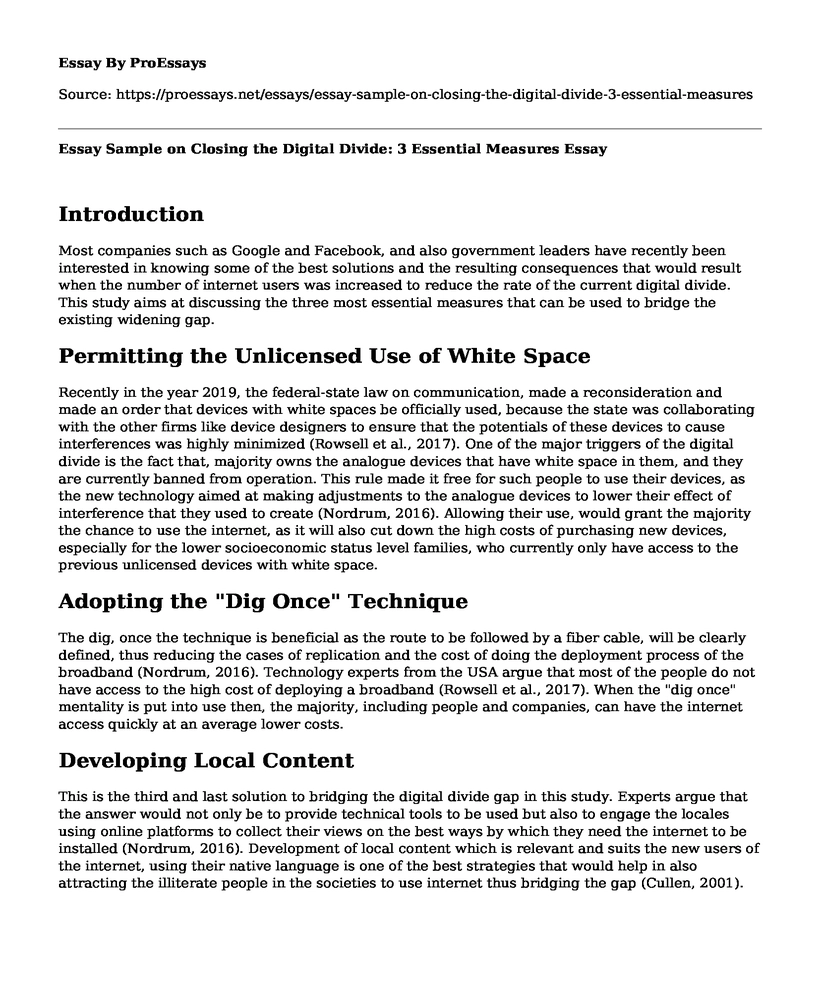Introduction
Most companies such as Google and Facebook, and also government leaders have recently been interested in knowing some of the best solutions and the resulting consequences that would result when the number of internet users was increased to reduce the rate of the current digital divide. This study aims at discussing the three most essential measures that can be used to bridge the existing widening gap.
Permitting the Unlicensed Use of White Space
Recently in the year 2019, the federal-state law on communication, made a reconsideration and made an order that devices with white spaces be officially used, because the state was collaborating with the other firms like device designers to ensure that the potentials of these devices to cause interferences was highly minimized (Rowsell et al., 2017). One of the major triggers of the digital divide is the fact that, majority owns the analogue devices that have white space in them, and they are currently banned from operation. This rule made it free for such people to use their devices, as the new technology aimed at making adjustments to the analogue devices to lower their effect of interference that they used to create (Nordrum, 2016). Allowing their use, would grant the majority the chance to use the internet, as it will also cut down the high costs of purchasing new devices, especially for the lower socioeconomic status level families, who currently only have access to the previous unlicensed devices with white space.
Adopting the "Dig Once" Technique
The dig, once the technique is beneficial as the route to be followed by a fiber cable, will be clearly defined, thus reducing the cases of replication and the cost of doing the deployment process of the broadband (Nordrum, 2016). Technology experts from the USA argue that most of the people do not have access to the high cost of deploying a broadband (Rowsell et al., 2017). When the "dig once" mentality is put into use then, the majority, including people and companies, can have the internet access quickly at an average lower costs.
Developing Local Content
This is the third and last solution to bridging the digital divide gap in this study. Experts argue that the answer would not only be to provide technical tools to be used but also to engage the locales using online platforms to collect their views on the best ways by which they need the internet to be installed (Nordrum, 2016). Development of local content which is relevant and suits the new users of the internet, using their native language is one of the best strategies that would help in also attracting the illiterate people in the societies to use internet thus bridging the gap (Cullen, 2001).
Reference
Cullen, R. (2001). Addressing the digital divide. Online information review, 25(5), 311-320.
Nordrum, A. (2016). 3 ways to bridge the digital divide [News]. IEEE Spectrum, 53(6), 9-10. Retrieved from https://ieeexplore.ieee.org/abstract/document/7473134/
Rowsell, J., Morrell, E., & Alvermann, D. E. (2017). Confronting the digital divide: Debunking brave new world discourses. The Reading Teacher, 71(2), 157-165. Retrieved from https://ila.onlinelibrary.wiley.com/doi/abs/10.1002/trtr.1603
Cite this page
Essay Sample on Closing the Digital Divide: 3 Essential Measures. (2023, Feb 12). Retrieved from https://proessays.net/essays/essay-sample-on-closing-the-digital-divide-3-essential-measures
If you are the original author of this essay and no longer wish to have it published on the ProEssays website, please click below to request its removal:
- Essay Sample on Horror Movies
- Schindler's List - Film Analysis Essay
- BBC Documentary on Iran and the West Paper Example
- Annotated Bibliography on Social Networking on Society
- Essay Example on Uniting the World with Music: The Power of Despacito
- Movie Analysis Essay on Stress, A portrait of a killer
- Essay Example on Overcoming Stage Fright: Learning the Art of Public Speaking







